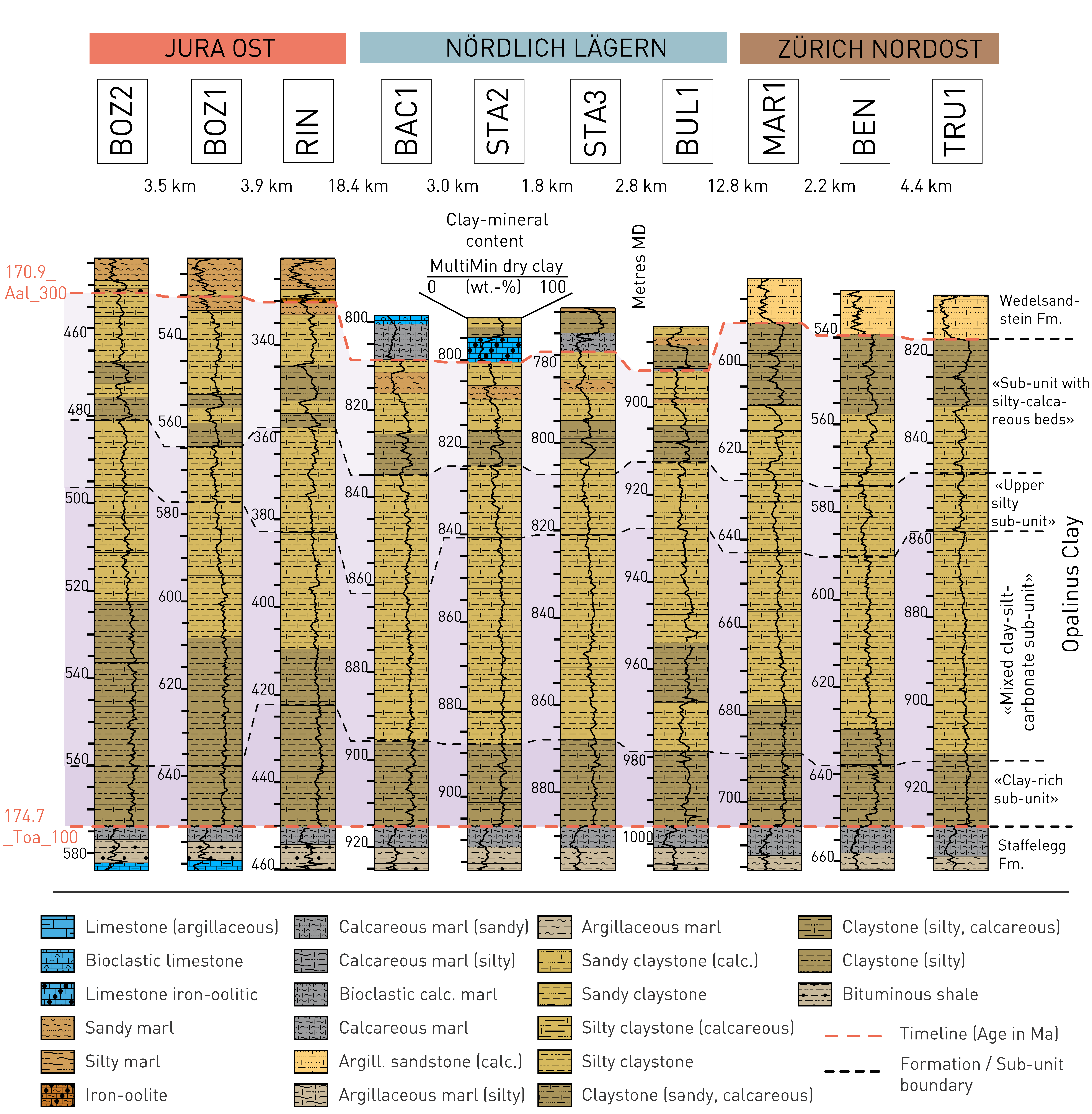The Opalinus Clay has the lithostratigraphic rank of a formation (Remane et al. 2005) and forms the lower part of the Dogger Group. The thickness of the Opalinus Clay is ca. 120 m in JO (BOZ2: 122 m, BOZ1: 121 m, RIN: 120 m), ca. 105 – 110 m in NL (BAC1: 107 m, WEI: 111 m, STA2: 106 m, STA3: 109 m, BUL1: 104 m) and ca. 115 m in ZNO (MAR1: 115 m, RHE1: 119 m [calculated true vertical depth TVD], BEN: 112 m, TRU1: 111 m) (Fig. 4‑27). The Opalinus Clay consists mostly of a fine sandy and silty claystone and claystone (sandy/silty, calcareous) (Fig. 4‑28, Fig. 4‑29).
There is no formal subdivision for the Opalinus Clay. In the past it had been subdivided into several dm- to m-scale subunits. This subdivision scheme was applied to the Opalinus Clay strata in the Nagra boreholes drilled in the 1980s and in the Mont Terri rock laboratory (e.g. Matter et al. 1988, Nagra 2001, Hostettler et al. 2017). This subdivision was refined by Mazurek & Aschwanden (2020) and applied to the TBO drilling campaign (Dossier III of TBO reports listed in Tab. 2‑1, Fig. 4‑28). From bottom to top this subdivision includes the following units: «Clay-rich sub-unit», «Mixed clay-silt-carbonate sub-unit», «Upper silty sub-unit» and «Sub-unit with silty calcareous beds». The additional «Carbonate-rich silty sub-unit» and the «Lower silty sub-unit» were only identified to the west of the study area.

Fig. 4‑28:Stratigraphic borehole correlation of the Opalinus Clay
For lithological nomenclature refer to Naef et al. (2019). Clay-mineral content after Becker & Marnat (2024) . Some of the boundaries and lithologies as discussed in the original reports were adjusted to integrate all presented borehole data.
Recent multi-proxy studies combining petrographic, petrophysical, geochemical and mineralogical analyses consider lithological heterogeneity on a cm- to dm-scale. Based on these analyses, a new subfacies classification scheme was developed at the Mont Terri rock laboratory by Lauper et al. (2018). This classification was also applied in the study area and developed further by Lauper et al. (2021b) and Zimmerli et al. (2024); the geosynthesis follows these principles. In the study area, the Opalinus Clay is dominated by three subfacies (Fig. 4‑30). The argillaceous subfacies 1 (SF1) consists of a dark grey, homogeneous claystone (sandy/silty, calcareous) (Fig. 4‑29a to c). Dispersed quartz, mica, feldspar grains and bioclastic fragments occur within the argillaceous matrix. SF1 dominates the lower half of the Opalinus Clay and repeatedly occurs in boreholes of NL and ZNO in the approximately uppermost part of this unit. The laminated subfacies 2 (SF2) is a silty claystone with lenticular bedding (Fig. 4‑29d and e). It shows an alternation of a dark grey, argillaceous matrix and continuous to discontinuous, light grey, quartz and bioclastic-rich lenses (thickness: few mm to few cm). Most lenses are cemented by a sparitic Fe-calcite. The lenticular subfacies 3 (SF3) consists of a silty and fine sandy claystone. This subfacies has a lenticular to wavy-bedded texture. The lenses become thicker from a few mm to several cm and the argillaceous matrix contains more quartz grains and bioclastic fragments than the previous subfacies types. SF2 and SF3 may occur over the entire thickness of the Opalinus Clay, except in the lowermost part (Fig. 4‑30). Additionally, sideritic nodules and layers (Fig. 4‑29b) may be found throughout the Opalinus Clay; they occur particularly frequently in approximately the second quarter of the Opalinus Clay (from the bottom). The sandy subfacies 4 (SF4) and the bioclastic subfacies 5 (SF5), as defined by Lauper et al. (2018) in the Mont Terri rock laboratory, were not identified in the boreholes of the study area. Zimmerli et al. (2024) define an additional homogeneous/deformed subfacies 6 (SF6). This subfacies is characterised by homogenised, folded, deformed or tilted structures related to soft-sediment deformation. It is dominated by clay minerals, calcite and quartz grains and may occur in approximately the second and third quarters of the Opalinus Clay. In the approximately uppermost quarter of the Opalinus Clay, additional cm- to dm-scale beds of silty limestone and limestone (iron-rich) (Fig. 4‑29f and g) occur. The silty limestone consists of silt- to sand-sized quartz grains, with micas, feldspars, bioclastic fragments, clay minerals, pseudosparitic calcite cement, and minor pyrite, and is highly bioturbated. The iron-rich or ferruginous limestone contains abundant bioclastic debris, lithoclasts, and some concretions.

